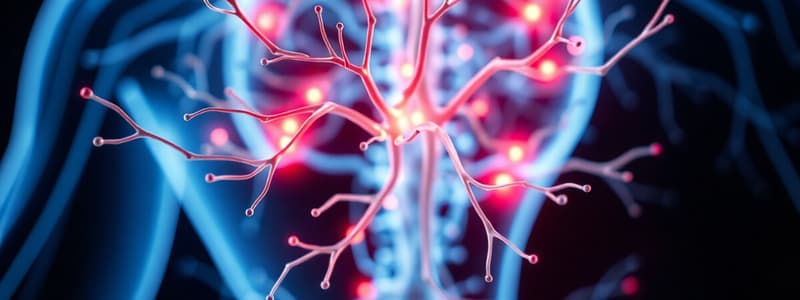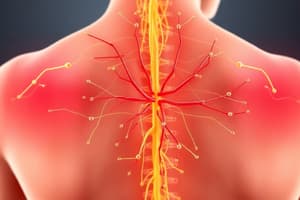Podcast
Questions and Answers
Which of the following characteristics best describe nerve pain?
Which of the following characteristics best describe nerve pain?
- Always felt as numbness only
- Not easily localized and can be dull or aching (correct)
- Consistently triggers sweating
- Well localized with sharp sensations
What type of pain is described as a sharp burning sensation?
What type of pain is described as a sharp burning sensation?
- Throbbing pain
- Numbness and tingling
- Deep dull cramping
- Superficial sharp burning (correct)
Which of the following symptoms could indicate activation of the sympathetic nervous system?
Which of the following symptoms could indicate activation of the sympathetic nervous system?
- Severe stomach cramps
- Chronic dull pain
- Increased sweating (correct)
- Numbness in limbs
What approach is suggested to manage a patient’s pain effectively?
What approach is suggested to manage a patient’s pain effectively?
What is a common belief about pain assessments in different cultures?
What is a common belief about pain assessments in different cultures?
Which of the following can be a misconception regarding pain experience?
Which of the following can be a misconception regarding pain experience?
What is one purpose of understanding cultural differences in healthcare?
What is one purpose of understanding cultural differences in healthcare?
What is an ineffective strategy for pain management according to best practices?
What is an ineffective strategy for pain management according to best practices?
Which type of pain is most likely to be described as throbbing or cramping?
Which type of pain is most likely to be described as throbbing or cramping?
What should be avoided to ensure effective cultural assessment in healthcare?
What should be avoided to ensure effective cultural assessment in healthcare?
Flashcards
Nerve pain localization
Nerve pain localization
Nerve pain is often difficult to pinpoint its exact location.
Nerve pain sensations
Nerve pain sensations
Nerve pain can feel like numbness, tingling, or sharp burning sensations.
Localized pain types
Localized pain types
Pain from direct injury is generally well-localized, and can be described as sharp or dull, aching, or throbbing.
Pain assessment
Pain assessment
Signup and view all the flashcards
Cultural factors in pain
Cultural factors in pain
Signup and view all the flashcards
Cultural assessment
Cultural assessment
Signup and view all the flashcards
Traditional healers
Traditional healers
Signup and view all the flashcards
Communication styles
Communication styles
Signup and view all the flashcards
Cultural practices affecting healthcare
Cultural practices affecting healthcare
Signup and view all the flashcards
Pain management
Pain management
Signup and view all the flashcards
Study Notes
Assessing Pain
- Pain is defined as an "unpleasant sensory and emotional experience associated with, or resembling that associated with, actual or potential tissue damage."
- Pain originates from the central nervous system (CNS) and/or peripheral nervous system (PNS).
- Nociceptors detect painful sensations from the periphery and transmit them to the CNS.
- Nociceptors are primarily located in the skin, joints, connective tissue, muscles, and thoracic, abdominal, and pelvic viscera.
- Nociceptors can be stimulated by mechanical or thermal stimuli or secondarily by chemical mediators released at the site of tissue damage.
- Two types of nociceptors exist:
- Aδ fibers: myelinated, larger in diameter, transmit fast pain, sensation localized, short-term, sharp in nature
- C fibers: unmyelinated, smaller in diameter, transmit pain signals slower, diffuse and aching, not easily localized.
- Nociceptive pain develops when functioning and intact nerve fibers in the periphery and CNS are stimulated, triggered by events outside the nervous system from actual or potential tissue damage.
- Nociceptive pain is divided into four phases:
- Transduction: Injured tissue releases chemicals to propagate the pain message; action potential moves along an afferent nerve fiber to the spinal cord.
- Transmission: Pain impulses move from the spinal cord to the brain.
- Perception: Signifies conscious awareness of a painful sensation.
- Modulation: Neurons from the brainstem release neurotransmitters that block pain impulses.
Neuropathic Pain
- Caused by a lesion or disease in the somatosensory nervous system.
- Implies abnormal processing of the pain message from an injury to the nerve fibers.
- Often the most difficult to assess and treat.
- Pain is perceived long after the site of injury heals, evolving into a chronic condition.
- Conditions that cause neuropathic pain include diabetes mellitus, shingles, HIV/AIDS, sciatica, phantom limb pain, numbness, and tingling.
Sources of Pain
- Cutaneous pain: skin or subcutaneous tissues- sharp, burning, superficial pain
- Visceral pain: larger internal organs (stomach, intestines, gallbladder, pancreas)- direct injury, deep, dull, cramping.
- Somatic pain: originates from musculoskeletal tissues or the body surface- well localized, sharp or dull, aching, throbbing.
- Deep somatic pain: blood vessels, joints, tendons, muscles, and bone.
- Referred pain: felt at a particular site but originates from another location.
Types of Pain
- Acute pain: short-term and self-limiting, follows a predictable trajectory, dissipates after injury heals.
- Chronic pain: continues for 6 months or longer, doesn't stop when injury heals—can be associated with neurological deficit. Can be malignant (due to tumor growth) or non-malignant (due to musculoskeletal conditions).
- Breakthrough pain: transient spike in pain level, moderate to severe in intensity, occurring in the context of otherwise controlled pain syndrome.
Opioid Epidemic
- In 2017, the U.S. Department of Health and Human Services declared the opioid crisis a public health emergency.
- Prescription opioid use increased in the late 1990s, with drug companies promoting their safety and effectiveness.
- Opioids are effective for severe pain but can cause various side effects due to receptor mechanisms and location.
Subjective Data (PQRST)
- Method for assessing pain:
- P: Provocation/Palliation (what caused/relieves pain; what makes it better/worse)
- Q: Quality/Quantity (what does the pain feel like? Use appropriate words)
- R: Region/Radiation (where is the pain located; does it radiate?)
- S: Severity (scale from 0-10)
- T: Timing (when did it start; how long does it last; how often does it occur?)
Pain Assessment Tools
- Initial Pain Assessment
- Numerical Rating Scale (NRS)
- Brief Pain Inventory
- Simple Descriptor Scale
- Visual Analogue Scale (VAS)
- Faces Pain Scale-Revised (FPS-R) (pediatrics)
Physiological responses to Pain
- Cardiac: tachycardia, elevated BP, increased myocardial oxygen demand.
- Pulmonary: hypoventilation, hypoxia, decreased cough, atelectasis.
- Gastrointestinal: nausea, vomiting, ileus, decreased motility.
- Renal: oliguria, urinary retention.
- Musculoskeletal: spasm, joint stiffness.
- Endocrine: increased adrenergic activity (activation of sympathetic nervous system).
- Immune: impaired cellular immunity and wound healing.
Nonverbal behaviors of Pain
- Acute pain: guarding, grimacing, vocalizations, restlessness, diaphoresis, change in vital signs.
- Chronic pain: bracing, rubbing, diminished activity, sighing, change in appetite.
Case Study
- Example of a patient in the post-anesthesia care unit after knee replacement.
- Describes pain assessment techniques.
- Emphasizes next steps in management following assessment (medication, repositioning, and heat packs).
Hierarchy of Pain Assessment Techniques
- Self-report-patient subjective data
- Search for potential causes of pain
- Observe client behavior
- Surrogate reporting-report from family member
- Attempt an analgesic trial (medicate to relieve pain)
Pain and Culture
- Psychosocial variables affect pain perception and management.
- Social Determinants of Health (SDOH) like low health literacy and socioeconomic status can impact pain management outcomes.
- Nurses should assess all aspects of the patient and complete a thorough pain assessment on all patients. Build rapport and ask open-ended questions.
Pain and the IDD Population
- Pain and distress can manifest atypically in patients with intellectual and developmental disabilities (IDD), especially those with limited communication.
- Look for nonspecific changes in behavior to assess for pain.
- Use adapted pain assessment tools.
- Common pain sources include injuries, dental caries, GERD, arthritis, constipation, and dysuria.
Assessing Culture
- Cultural competence involves understanding different cultures' perceptions of health and illness.
- Heritage consistency, ethnicity, and religion influence patients' views on health and healthcare.
- Discuss areas of potential cultural conflicts between nurses and patients of different ethnic groups.
- Examine the influence of the health belief system on health practices and illness expressions.
- Understand components of the health belief system and recognize sources of cultural influence in the students own beliefs and experiences.
- Provide patient-centered care that respects cultural diversity.
Demographics of the U.S.
- The U.S. population exceeds 328 million.
- 18% identify as Hispanic or Latino, and 60.1% identify as White alone.
- Over 13% of the U.S. population is foreign-born.
- 22% of the U.S. population speak a language other than English at home.
Social Determinants of Health
- Key social determinants of health are education access/quality, economic stability, neighborhood/built environment, and social and community context.
- Poverty is the most impactful social determinant.
Health Disparities
- Health disparities are a particular type of health difference closely linked to social, economic, and environmental disadvantage, affecting groups systematically based on racial, ethnic, or other characteristics. This can include differences based on religion, socioeconomic status, gender, mental health, cognitive, sensory, physical disability, sexual orientation, gender identity, geographic location, and historical discrimination and exclusion.
Culture
- Culture is a complex phenomenon that includes attitudes, beliefs, self-definitions, norms, roles, and values, transmitted through socialization or enculturation.
- Socialization/enculturation describes the process of being raised within a culture and adopting its norms, values, and behaviors.
- A person's culture defines their views on health, illness, acceptable treatments and how symptoms are expressed.
Basic Culture Characteristics
- Learned from birth through language acquisition and socialization.
- Shared by members of the same cultural group.
- Adapted to specific conditions related to the environment and resources.
- Dynamic and ever changing.
Culturally Sensitive Practitioner
- Cultural awareness: recognizing one's own culture.
- Cultural knowledge: learning about other cultures.
- Cultural skills: gaining skills for cultural assessment and providing care for diverse populations.
- Cultural humility: acknowledging and appreciating different beliefs.
Cultural Assessment
- No single tool is the gold standard.
- Avoid assuming cultural understanding; instead, ask about cultural beliefs impacting care.
Domains of Cultural Assessment
- Heritage/country history
- Health practices, traditions
- Communication preferences
- Family roles
- Nutrition
- Pregnancy, birth, child-rearing
- Spirituality/religion
- Death/beliefs around death & grief
- Health care providers
Studying That Suits You
Use AI to generate personalized quizzes and flashcards to suit your learning preferences.




